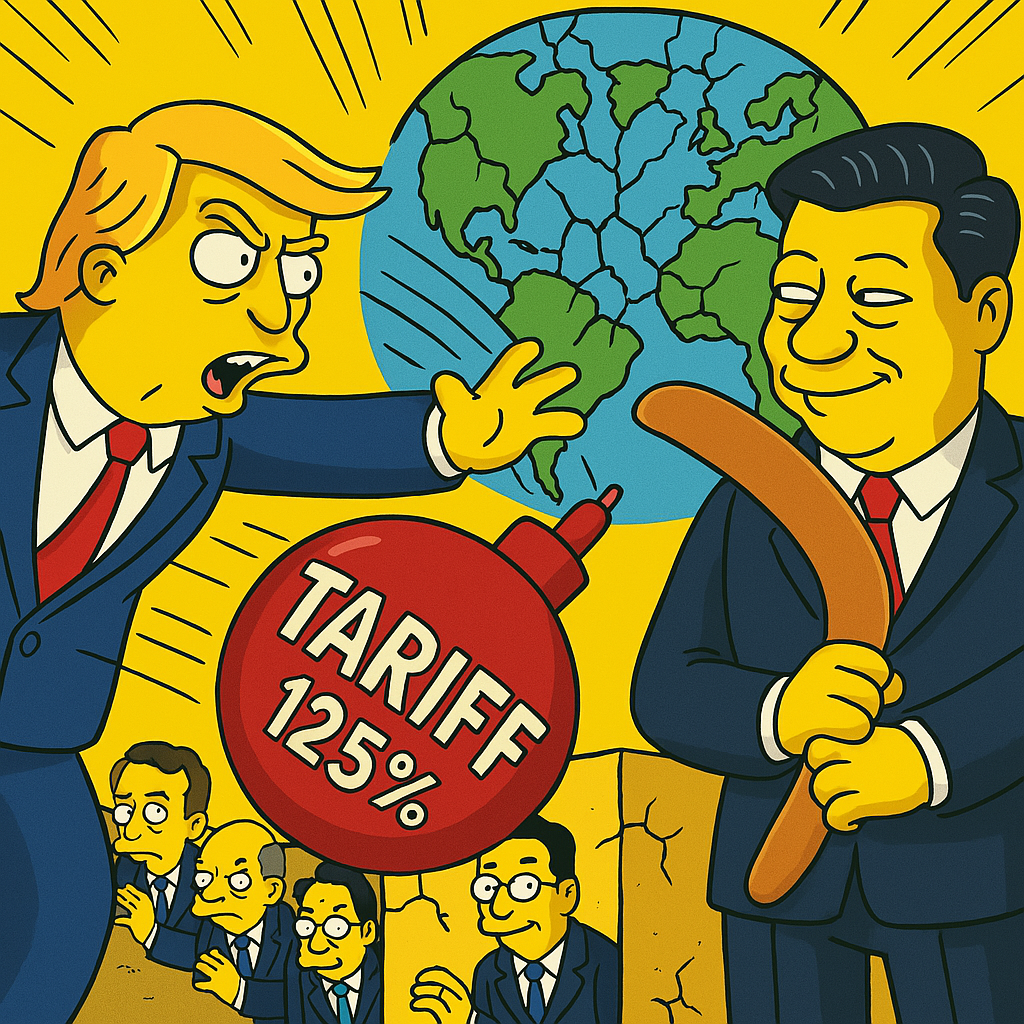💬 It’s April 2025, and the heartbeat of the global economy is racing again. Since Donald Trump’s re-election, the United States has reignited the US-China trade war by imposing high tariffs of 125% on Chinese imports. This has sent global supply chains and financial markets reeling, and we’re facing another wave of uncertainty.

In April 2025, the U.S.-China trade conflict reignited, adding to global economic uncertainty. We analyze the escalating economic war, including high tariffs, stock market declines, and fluctuations in the Korean economy’s exports and imports, and present future prospects.
🔍 Issue brief: The ‘tariff wars’ are back
Since former President Donald Trump’s return to power, the United States has reintroduced tough trade policies aimed at China. In early April 2025, the White House made a surprise announcement that it would impose high-rate tariffs of up to 125% on key imports from China. This was an extension of the first US-China trade war in 2018-2019, and global markets reacted immediately.
왜 지금?
- 🇺🇸 U.S. trade deficit widens
- 🗳️ Fulfilling Trump’s protectionist promises
- 🇨🇳 Curbing China’s high-tech rollout
- 📉 Accelerate manufacturing reshoring (bring back home)
Against this backdrop, the US’s high-rate tariffs are being interpreted not just as an economic measure, but as an escalation of geopolitical competition.
📊 The current situation: plunging stock prices, trade deficits, supply chain crises
1. 📉 Global stock market reactions
Immediately following the announcement of the US tariffs, the New York stock market plunged in unison.
- Nasdaq -3.2
- S&P500 -2.5
- Dow Jones -2.1
In particular, tech and consumer stocks were hit hard, with shares of large, China-dependent companies such as Apple, Tesla, and Nvidia falling.
2. 🚢 South Korea Trade Trends
According to the Korea International Trade Association, exports grew 13.7% year-over-year from April 1-10, but imports grew even more, leaving the country with a $1.1 billion trade deficit. Rising import prices of energy and raw materials, currency fluctuations are the main reasons for the increase.
3. 🧩 Signs of supply chain realignment
- Apple, Intel, and others considering shifting production from China to India, Vietnam, and elsewhere
- Korean companies such as Samsung Electronics and LG have also begun to diversify their supply chain risks.
- Accelerating global supply chain ‘decoupling’ for semiconductors, batteries, and rare earths

🎯 Expert analysis: It’s not just a trade war
🔬 ① U.S. strategy: restructuring beyond simple import restrictions
The U.S. has made no secret of its intentions to not only improve its trade balance in the short term, but also to gain the upper hand in the technological superpower war, particularly to curb China’s rise in future industries such as AI, semiconductors, and biotech.
🧮 ② China’s response: retaliatory tariff cards are on the table
China has yet to retaliate directly, but reports have surfaced that it is considering higher tariffs on U.S. products in the agricultural, aircraft, and automotive sectors. There is also the possibility of rare earth export controls or tighter regulations on U.S. companies.
🧠 ③ Market Interpretation: Another Black Swan?
In 2025, global markets are in a multi-risk state, with inflationary concerns, persistently high interest rates, and geopolitical risks. Add to that the US-China conflict, and investors are becoming more risk-averse, which some have characterized as a “black swan event.
🔮 Looking ahead: 4 things to watch for
✅ 1. Cascading effect of tariffs → exchange rates → exporters’ performance
High-rate tariffs also affect global currency markets. A chain reaction can occur: weaker currency → higher import prices → slower consumption. At the same time, it also increases earnings uncertainty for Korean companies that rely heavily on exports.
✅ 2. Alternative strategies for South Korea
- Export Diversification: Expanding into Southeast Asia, the Middle East, and Latin America
- Manage supply chain risk: Multinationalize your manufacturing base
- Technology localization: Strengthening in-house supply capabilities for semiconductors, materials, and equipment
✅ 3. Financial market forecasting
- Gold Price Rises (Increased Demand for Risk Hedging)
- Dollar continues to strengthen
- Global equity markets expected to ‘selectively rebound’ after short-term correction
✅ 4. Possible US-China political agreement?
🧾 Conclusion: In an era of uncertainty, what do we need to prepare for?
The U.S.-China trade conflict is more than just a confrontation between two nations; it signals a reshaping of the global economy. As individuals, businesses, and governments, we all need to prepare for the following
- 🎯 Diversify your risk
- 🎯 Flexibility to respond to market volatility
- 🎯 Invest in new growth markets and technologies
This is a critical juncture where you can find opportunity in the midst of uncertainty.
📌 References
- 연합뉴스 (https://www.yna.co.kr/view/AKR20250411033951002)
- Bloomberg, Wall Street Journal
- Korea International Trade Association, Korea Institute of Industrial Economics
- IMF, OECD reports cited
#미중무역갈등 #관세전쟁 #글로벌경제위기 #트럼프정책 #중국수출입 #무역전쟁 #금융시장분석 #2025경제이슈 #한국수출입 #공급망위기 #환율전망 #주식시장전망
#USChinaTradeWar #TariffCrisis #GlobalEconomy #TrumpTradePolicy #ExportImport #SupplyChainDisruption #StockMarket2025 #KoreaTradeDeficit #EconomicForecast #FinancialCrisisAlert

